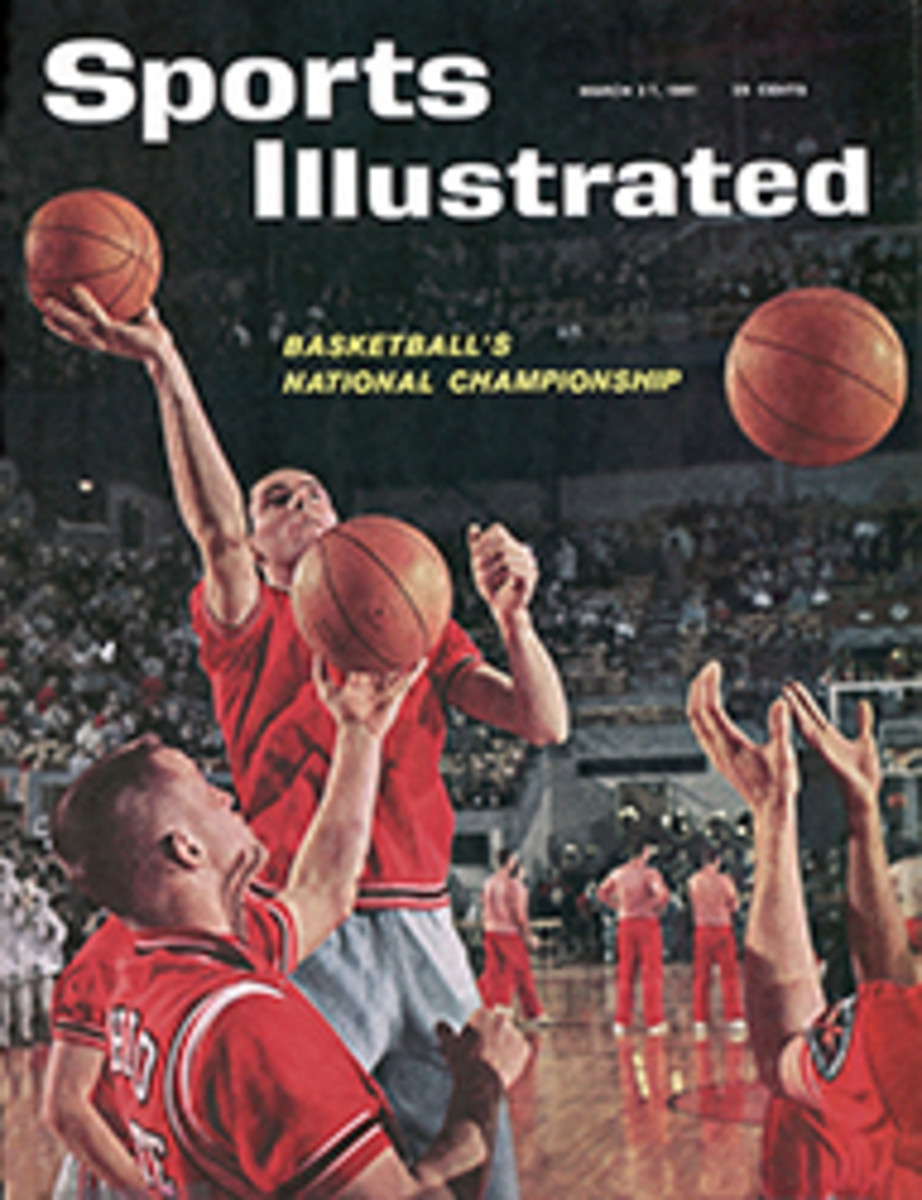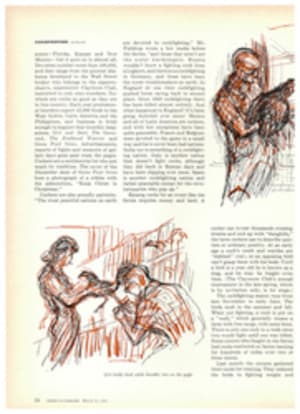
OHIO STATE ALL THE WAY
In the midst of the basketball scandals, ironically enough, 16 college teams fighting for a national championship were showing off the game at its glittering and unpredictable best. With a trip to this weekend's final rounds of the NCAA tournament in Kansas City at stake, the teams played in four regional tournaments that were bursting with hoopla and excitement. There was standing room only at Charlotte, N.C., where a rank outsider won, while at Louisville, where tickets were selling for $30 each, 18,000 sat in disbelief watching a local team dramatically display that Ohio State could be beaten—almost. At Lawrence, Kans. defense won when two coaches guessed wrong, and at Portland, Ore. a blazing offense produced a western champion. The class of the teams that won assured a spectacular finale at Kansas City, and the regional tournaments demonstrated that while things may be wrong with some of the people in basketball, nothing is wrong with the game itself.
At Charlotte the darling of the packed house was, naturally enough, the southern entry, Wake Forest, which had demolished highly favored St. John's earlier in the week at New York. "We're hot, and it's the hot team that wins tournaments," prophesied Wake Forest's preacher-coach Bones McKinney. He proved, however, to be a pained prophet without honor, though nonetheless correct.
On Friday night his Deacons took on the nation's third-ranked team, St. Bonaventure, and upset it 78-73 in a battle of defenses. Len Chappell, the 240-pound Wake Forest center, surprised the Bonnies with his soft outside shots and destroyed them by getting 15 rebounds. The 6-foot-8 Chappell, looking like Li'l Abner in underwear, had been stung by All-America snubs, and he led his team to heights it hadn't reached all year. Charlotte, where you couldn't buy a ticket for a week, was agog. Nobody paid much attention to St. Joseph's, which won its 14th straight when it slipped by an inspired Princeton team 72-67.
The next night Bones McKinney found out that, indeed, the hot team would win. Using two sophomore guards, Jim Lynam, a moonfaced 5-foot-8 dynamo, and scrawny 6-foot Bill Hoy, who shoots as well off balance as on, St. Joseph's ran its deliberate offense to red-hot perfection, stealing away to a 20-point lead at half time. Slope-shouldered Jack Ramsay, the St. Joseph's coach, who had spent most of the contest prayerfully on one knee, waved to the tiny Hawk rooting section as the game ended 96 to 86. Two students there, who had hitchhiked to Charlotte, immediately set off in the rain, this time hitchhiking to Kansas City.
Warm fans and a cold team
If St. Joseph's surprised everybody by winning, Ohio State surprised everybody by nearly losing. In Louisville, Man o' War could have raced eight furlongs down Walnut Street with Lady Godiva up and created no more excitement. Tickets had been impossible to get for two weeks, largely because three Kentucky schools, Louisville, Morehead State and Kentucky, were in the regional. The only outsider, of course: Ohio State. Meanwhile, thousands of fans had come into town from Ohio, with their own bands, their own bottles and their own certainty Ohio State could defeat any Kentucky team.
On Friday night Louisville caught the champions ice cold. They crowded three men around the incomparable Jerry Lucas. The Buckeyes were so bad they could only hit one outside shot in the first half, and Louisville had a five-point lead with three minutes left. That should have been enough.
But a jump shot, a stolen pass, and a three-point play by Ohio State tied the score. Then, with less than a minute to go, Louisville's handsome star, John Turner, a Hollywood-idol type who had scored 24 points, bounced the ball off his toe. Ohio State came up with it, and when an emergency scoring play failed, John Havlicek improvised a 20-footer with six seconds left. Not beaten yet, Louisville's Turner had two foul shots with one second to play, and saw the tying point roll off the rim as OSU won 56-55.
Lucas, held to nine points, his lowest total since grammar school, had also made nine errors. "I was guarded so tightly I felt like I was in jail," he said.
Kentucky had to come from behind in the second game to fend off a Morehead State team that has the same hillbilly act as Sam Snead, and is just as dangerous. "We're nothing but pore country boys," their coach, Bob Laughlin, told everyone. But with Granny Williams, a dead-eye guard from Dwarf, Ky.—an aptly named town of five homes and a backboard—the country boys scared Adolph Rupp. It took 28 points by Kentucky ace Bill Lickert for Rupp's team to win.
After those two games Saturday had to be, and was, anticlimactic.
Rupp, the master strategist, declined to take a hint from what Louisville had accomplished against Lucas. His team played its classic man-to-man defense, two men fouled out trying to cope with Lucas, and Ohio State overwhelmed Kentucky 87-74. Lucas made 14 of 18 field-goal tries, scored 33 points, captured a magnificent 30 rebounds. "That team," said Rupp, "is truly great. They're going all the way."
At Lawrence both Cincinnati and Kansas State had no trouble beating Texas Tech and Houston respectively on the first night, and their game against each other appeared to revolve around Cincinnati's 6-foot-9 Center Paul Hogue, who resembles a large oak tree that has been granted the power to move—fast.
But Hogue fouls too much. Cincinnati Coach Ed Jucker figured he was beaten if he had to bench Hogue, and Kansas State Coach Tex Winter thought he would have a good chance if his team stopped Hogue. Both were wrong. Trailing, Cincinnati was forced to bench Hogue when he got his fourth foul as the second half started. In came a sub, but Cincinnati continued to control the boards, finally caught Kansas State with 10 minutes left and won 69-64. It was Cincinnati's 20th straight win, thanks as usual to its tenacious defense.
Defense had nothing to do with determining the winner at Portland. Behind Billy McGill, their 6-foot-9 center who has the speed of a dash man, Utah accomplished what it has done so often this season—exhausting an opponent with its fast-break attack and then romping to an easy win. The Utes did it against Loyola of Los Angeles Friday night, 91-75. Against surprising Arizona State on Saturday night, Utah raced to 17 straight points late in the first half while State couldn't score at all, and that was enough for an 88-80 win. The night before, Arizona had pulled the tournament's biggest upset by soundly beating Southern California 86-71.
The four teams going to Kansas City have an interesting combination of traits and talents. Two, Ohio State and Utah, have superb offenses with fast, accurate attacks. They rank second and third nationally, with shooting percentages of .495 and .494. Cincinnati and St. Joseph's have more deliberate—and less effective—offenses, but Cincinnati has its defense and St. Joseph's has that tournament intangible: the role of underdog with nothing to lose.
Louisville proved that Ohio State can be cut down, but St. Joseph's, which plays OSU in the semifinal, is not likely to do it. In Jack Egan the team has a very good jump shot, but the guards are too short at 5 feet 8 and 6 feet to cope with Ohio State's Larry Siegfried (6 feet 4) and Mel Nowell (6 feet 2), nor does St. Joseph's have the height in the front court to try Louisville's gamble of putting three men around Lucas.
When Cincinnati meets Utah it is likely that Bearcat Coach Jucker will not risk putting Hogue on McGill, for McGill has the moves and shots to force Hogue to foul out in five minutes. This leaves 6-foot-2 Tom Thacker with the unenviable job of guarding McGill and, with burly 6-foot-4 Bob Wiesenhahn, much of the responsibility for the rebounding that Cincinnati must have. On the other hand, Cincinnati is just the team to jam Utah's fast break. Utah has shown lately that it can operate at a slower speed, but it has not faced a team with Cincinnati's defensive finesse.
Thus, if Hogue fouls out, Utah should be in, but if he does not, there will be the clash of basic basketball styles—offense against defense—that has often of late been resolved in favor of the defense.
A Utah-Ohio State finale would set up a dazzling battle of centers that could well amount to a standoff. McGill has shown he can accomplish more offensively than Lucas, but Lucas is unquestionably a better defensive center. If they cancel each other, Ohio State would be likely to win on two counts: defense, at which it far surpasses Utah, and team balance. But if McGill can greatly out-score Lucas or lure him into foul trouble (which nobody has ever done) Utah could win it all.
If Cincinnati makes the finals it might very well control the backboards as it has all season. But it shares the same reserve weakness that Ohio State has (nobody will have a strong bench at Kansas City) and must live once again like a man on the edge of a cliff because of Hogue's fouling. Ohio State has just the driving offense to force Hogue to foul.
Thus, though there may be a blistering offensive battle in the finals at Kansas City if Utah gets past Cincinnati, it looks like wise old Adolph Rupp is right: Ohio State all the way.
TWO PHOTOS
THREE-AGAINST-ONE Louisville defense swarms around Ohio State's Jerry Lucas as John Havlicek (5) risks ill-advised pass to beleaguered teammate. Louisville's near win had home-town cheerleaders whirling (below) before disastrous last minute.
PHOTO
BLOCKING OFF PRINCETON FOE, ST. JOSEPH'S VINCENT KEMPTON TAKES A REBOUND

